Human Resource Fundamentals: Union Membership and Right to Work
VerifiedAdded on 2022/11/25
|8
|1556
|174
Discussion Board Post
AI Summary
This discussion board post explores the fundamentals of human resources, focusing on union membership and right-to-work laws. It begins with a case study of Harley Davidson, illustrating the dynamics between labor unions and management, including negotiation strategies and cost considerations during economic downturns. The post then defines union membership, its benefits to workers (such as higher wages and better benefits), and the different types of unions. The discussion continues with an examination of right-to-work laws, their impact on employment, and the arguments for and against them. It highlights how these laws affect union membership and the financial stability of unions, while also considering the broader economic implications and the role of the state in addressing unemployment. Finally, it references relevant literature from various sources to support its claims.
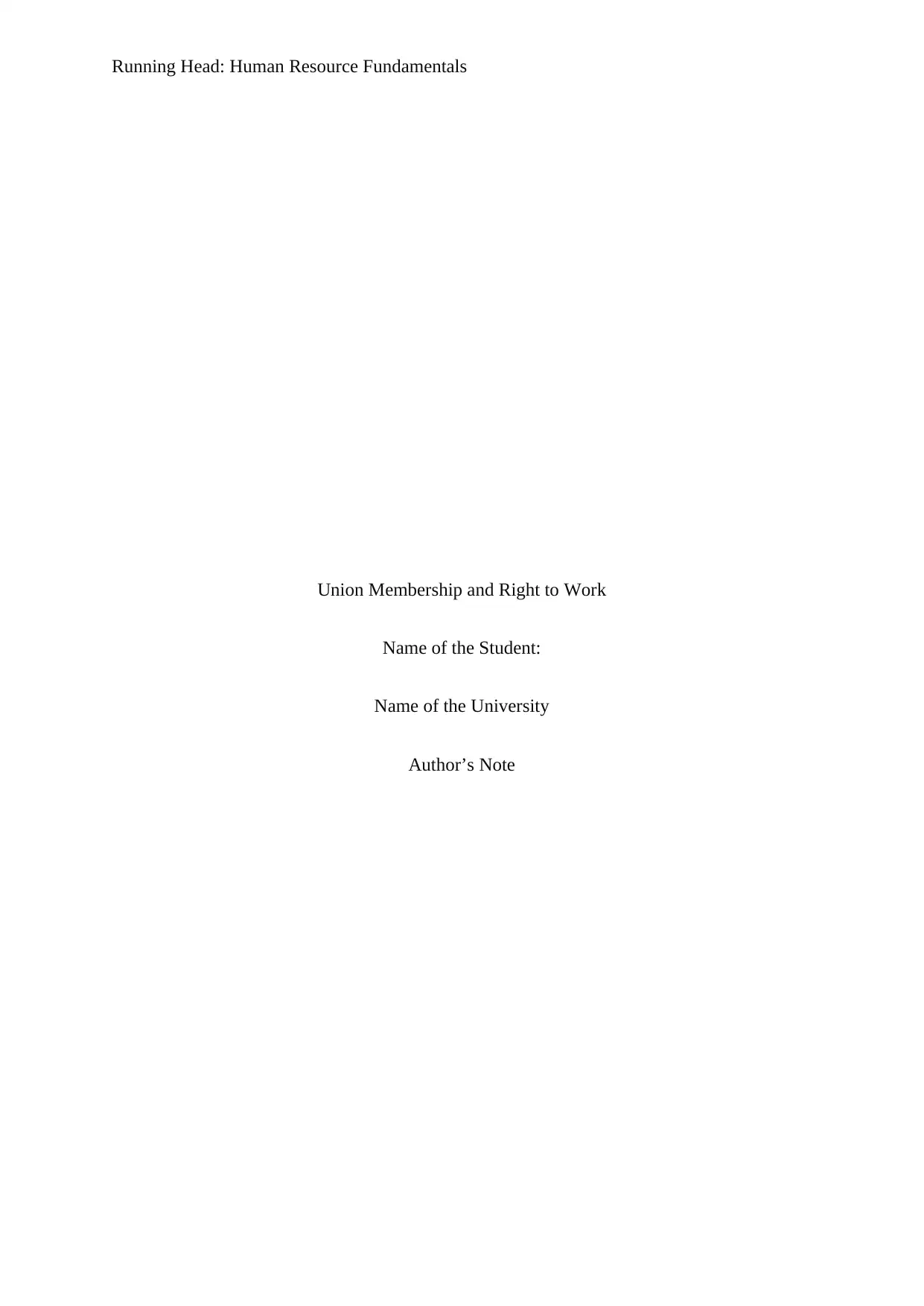
Running Head: Human Resource Fundamentals
Union Membership and Right to Work
Name of the Student:
Name of the University
Author’s Note
Union Membership and Right to Work
Name of the Student:
Name of the University
Author’s Note
Paraphrase This Document
Need a fresh take? Get an instant paraphrase of this document with our AI Paraphraser
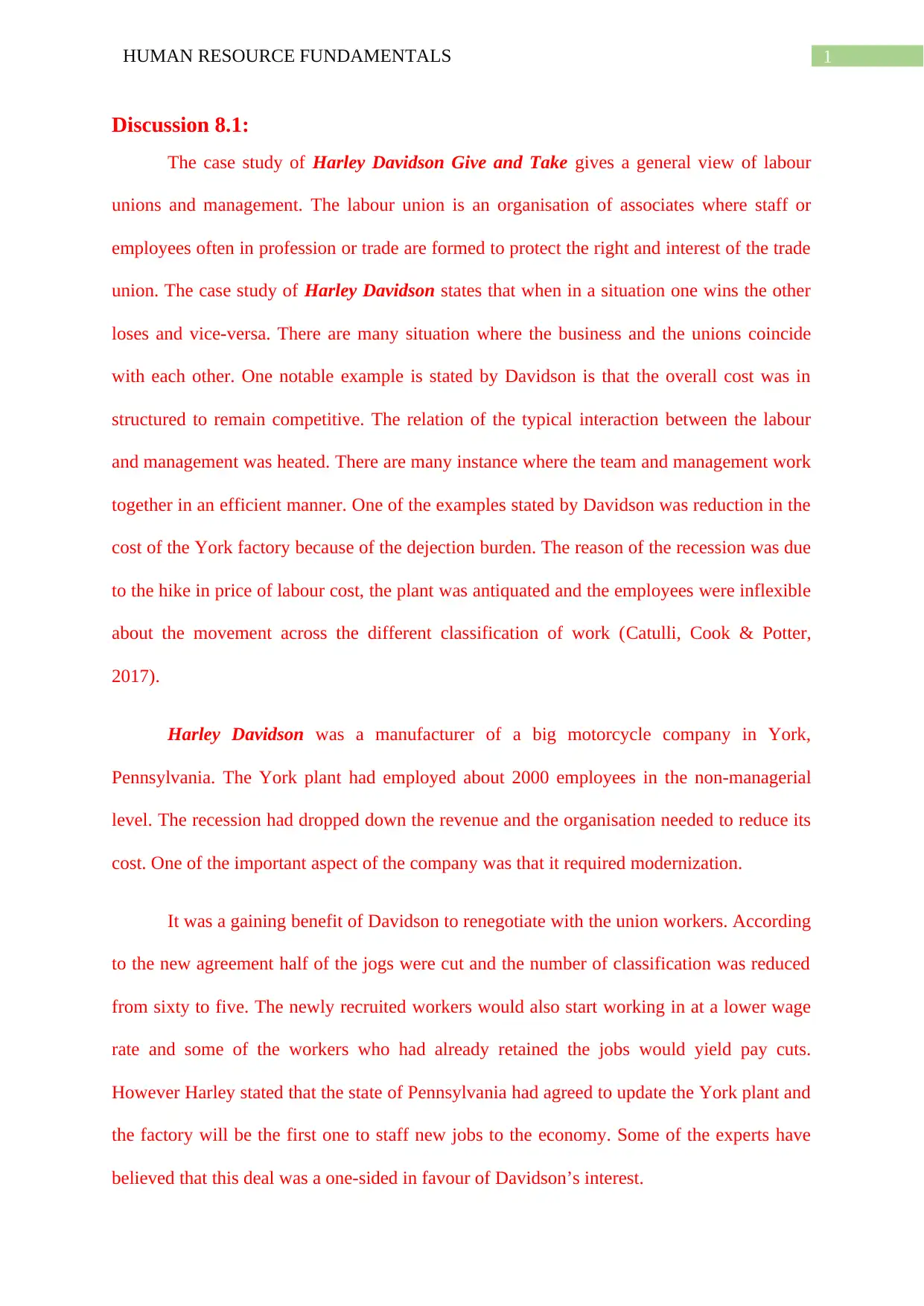
1HUMAN RESOURCE FUNDAMENTALS
Discussion 8.1:
The case study of Harley Davidson Give and Take gives a general view of labour
unions and management. The labour union is an organisation of associates where staff or
employees often in profession or trade are formed to protect the right and interest of the trade
union. The case study of Harley Davidson states that when in a situation one wins the other
loses and vice-versa. There are many situation where the business and the unions coincide
with each other. One notable example is stated by Davidson is that the overall cost was in
structured to remain competitive. The relation of the typical interaction between the labour
and management was heated. There are many instance where the team and management work
together in an efficient manner. One of the examples stated by Davidson was reduction in the
cost of the York factory because of the dejection burden. The reason of the recession was due
to the hike in price of labour cost, the plant was antiquated and the employees were inflexible
about the movement across the different classification of work (Catulli, Cook & Potter,
2017).
Harley Davidson was a manufacturer of a big motorcycle company in York,
Pennsylvania. The York plant had employed about 2000 employees in the non-managerial
level. The recession had dropped down the revenue and the organisation needed to reduce its
cost. One of the important aspect of the company was that it required modernization.
It was a gaining benefit of Davidson to renegotiate with the union workers. According
to the new agreement half of the jogs were cut and the number of classification was reduced
from sixty to five. The newly recruited workers would also start working in at a lower wage
rate and some of the workers who had already retained the jobs would yield pay cuts.
However Harley stated that the state of Pennsylvania had agreed to update the York plant and
the factory will be the first one to staff new jobs to the economy. Some of the experts have
believed that this deal was a one-sided in favour of Davidson’s interest.
Discussion 8.1:
The case study of Harley Davidson Give and Take gives a general view of labour
unions and management. The labour union is an organisation of associates where staff or
employees often in profession or trade are formed to protect the right and interest of the trade
union. The case study of Harley Davidson states that when in a situation one wins the other
loses and vice-versa. There are many situation where the business and the unions coincide
with each other. One notable example is stated by Davidson is that the overall cost was in
structured to remain competitive. The relation of the typical interaction between the labour
and management was heated. There are many instance where the team and management work
together in an efficient manner. One of the examples stated by Davidson was reduction in the
cost of the York factory because of the dejection burden. The reason of the recession was due
to the hike in price of labour cost, the plant was antiquated and the employees were inflexible
about the movement across the different classification of work (Catulli, Cook & Potter,
2017).
Harley Davidson was a manufacturer of a big motorcycle company in York,
Pennsylvania. The York plant had employed about 2000 employees in the non-managerial
level. The recession had dropped down the revenue and the organisation needed to reduce its
cost. One of the important aspect of the company was that it required modernization.
It was a gaining benefit of Davidson to renegotiate with the union workers. According
to the new agreement half of the jogs were cut and the number of classification was reduced
from sixty to five. The newly recruited workers would also start working in at a lower wage
rate and some of the workers who had already retained the jobs would yield pay cuts.
However Harley stated that the state of Pennsylvania had agreed to update the York plant and
the factory will be the first one to staff new jobs to the economy. Some of the experts have
believed that this deal was a one-sided in favour of Davidson’s interest.
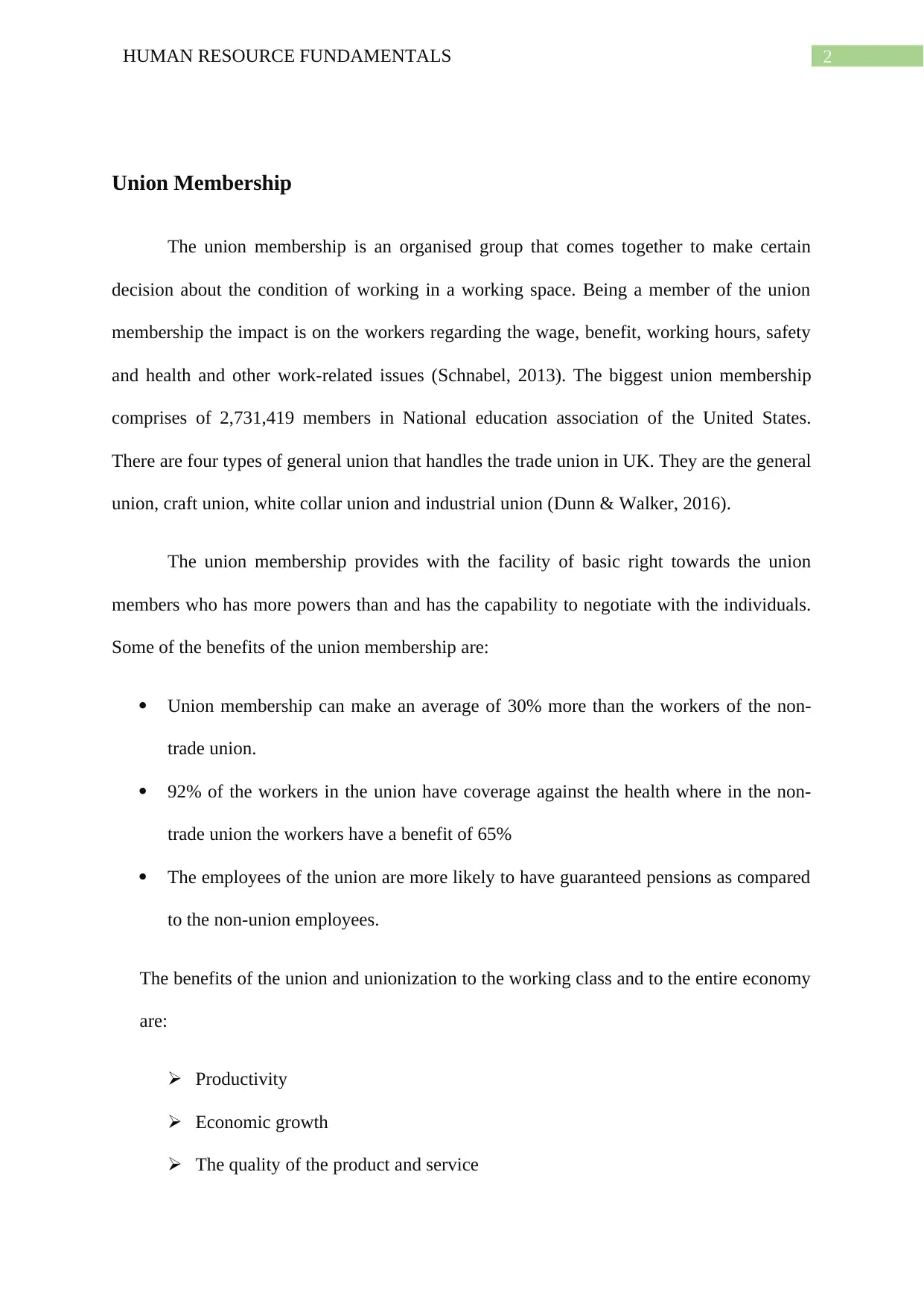
2HUMAN RESOURCE FUNDAMENTALS
Union Membership
The union membership is an organised group that comes together to make certain
decision about the condition of working in a working space. Being a member of the union
membership the impact is on the workers regarding the wage, benefit, working hours, safety
and health and other work-related issues (Schnabel, 2013). The biggest union membership
comprises of 2,731,419 members in National education association of the United States.
There are four types of general union that handles the trade union in UK. They are the general
union, craft union, white collar union and industrial union (Dunn & Walker, 2016).
The union membership provides with the facility of basic right towards the union
members who has more powers than and has the capability to negotiate with the individuals.
Some of the benefits of the union membership are:
Union membership can make an average of 30% more than the workers of the non-
trade union.
92% of the workers in the union have coverage against the health where in the non-
trade union the workers have a benefit of 65%
The employees of the union are more likely to have guaranteed pensions as compared
to the non-union employees.
The benefits of the union and unionization to the working class and to the entire economy
are:
Productivity
Economic growth
The quality of the product and service
Union Membership
The union membership is an organised group that comes together to make certain
decision about the condition of working in a working space. Being a member of the union
membership the impact is on the workers regarding the wage, benefit, working hours, safety
and health and other work-related issues (Schnabel, 2013). The biggest union membership
comprises of 2,731,419 members in National education association of the United States.
There are four types of general union that handles the trade union in UK. They are the general
union, craft union, white collar union and industrial union (Dunn & Walker, 2016).
The union membership provides with the facility of basic right towards the union
members who has more powers than and has the capability to negotiate with the individuals.
Some of the benefits of the union membership are:
Union membership can make an average of 30% more than the workers of the non-
trade union.
92% of the workers in the union have coverage against the health where in the non-
trade union the workers have a benefit of 65%
The employees of the union are more likely to have guaranteed pensions as compared
to the non-union employees.
The benefits of the union and unionization to the working class and to the entire economy
are:
Productivity
Economic growth
The quality of the product and service
⊘ This is a preview!⊘
Do you want full access?
Subscribe today to unlock all pages.

Trusted by 1+ million students worldwide
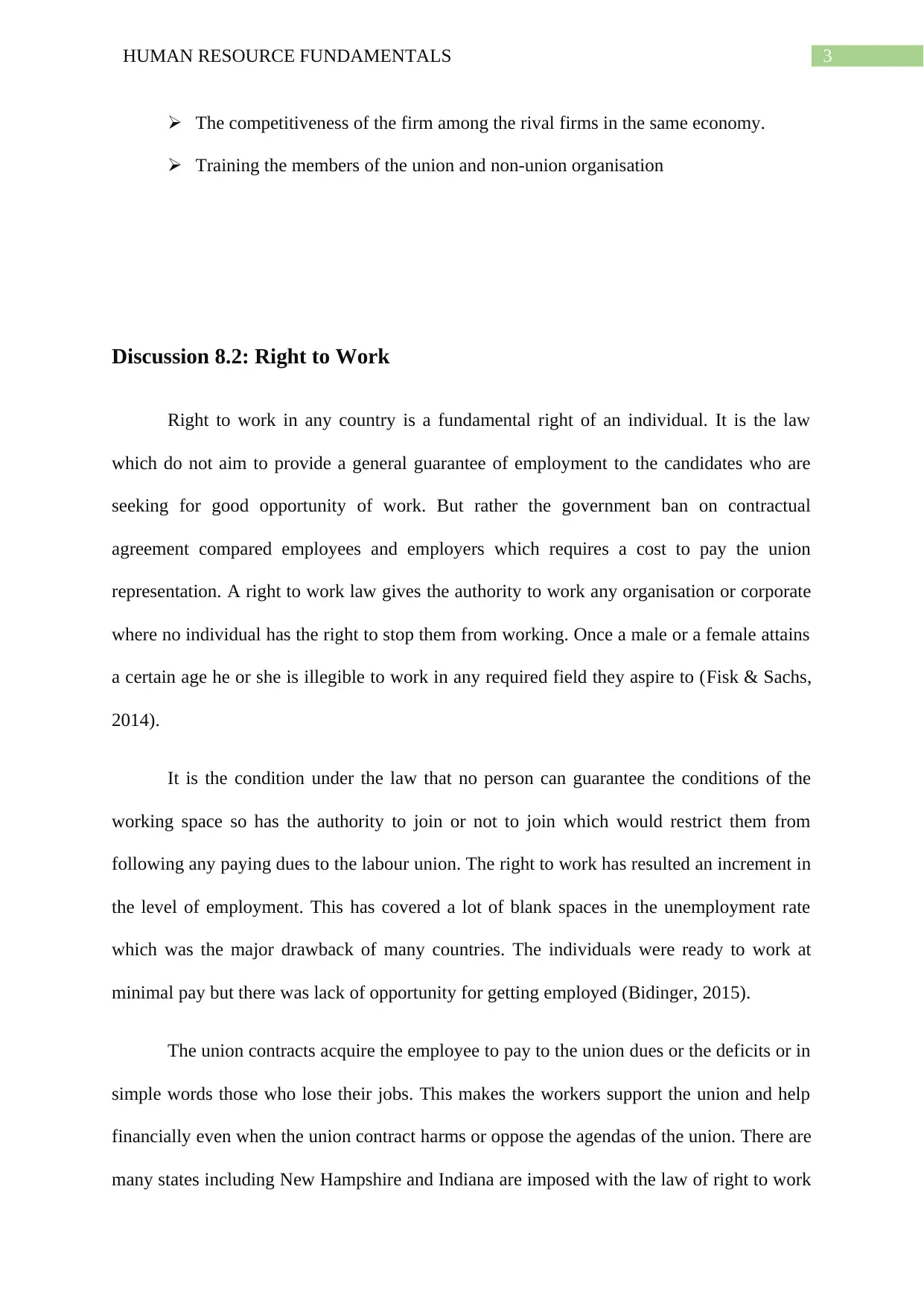
3HUMAN RESOURCE FUNDAMENTALS
The competitiveness of the firm among the rival firms in the same economy.
Training the members of the union and non-union organisation
Discussion 8.2: Right to Work
Right to work in any country is a fundamental right of an individual. It is the law
which do not aim to provide a general guarantee of employment to the candidates who are
seeking for good opportunity of work. But rather the government ban on contractual
agreement compared employees and employers which requires a cost to pay the union
representation. A right to work law gives the authority to work any organisation or corporate
where no individual has the right to stop them from working. Once a male or a female attains
a certain age he or she is illegible to work in any required field they aspire to (Fisk & Sachs,
2014).
It is the condition under the law that no person can guarantee the conditions of the
working space so has the authority to join or not to join which would restrict them from
following any paying dues to the labour union. The right to work has resulted an increment in
the level of employment. This has covered a lot of blank spaces in the unemployment rate
which was the major drawback of many countries. The individuals were ready to work at
minimal pay but there was lack of opportunity for getting employed (Bidinger, 2015).
The union contracts acquire the employee to pay to the union dues or the deficits or in
simple words those who lose their jobs. This makes the workers support the union and help
financially even when the union contract harms or oppose the agendas of the union. There are
many states including New Hampshire and Indiana are imposed with the law of right to work
The competitiveness of the firm among the rival firms in the same economy.
Training the members of the union and non-union organisation
Discussion 8.2: Right to Work
Right to work in any country is a fundamental right of an individual. It is the law
which do not aim to provide a general guarantee of employment to the candidates who are
seeking for good opportunity of work. But rather the government ban on contractual
agreement compared employees and employers which requires a cost to pay the union
representation. A right to work law gives the authority to work any organisation or corporate
where no individual has the right to stop them from working. Once a male or a female attains
a certain age he or she is illegible to work in any required field they aspire to (Fisk & Sachs,
2014).
It is the condition under the law that no person can guarantee the conditions of the
working space so has the authority to join or not to join which would restrict them from
following any paying dues to the labour union. The right to work has resulted an increment in
the level of employment. This has covered a lot of blank spaces in the unemployment rate
which was the major drawback of many countries. The individuals were ready to work at
minimal pay but there was lack of opportunity for getting employed (Bidinger, 2015).
The union contracts acquire the employee to pay to the union dues or the deficits or in
simple words those who lose their jobs. This makes the workers support the union and help
financially even when the union contract harms or oppose the agendas of the union. There are
many states including New Hampshire and Indiana are imposed with the law of right to work
Paraphrase This Document
Need a fresh take? Get an instant paraphrase of this document with our AI Paraphraser
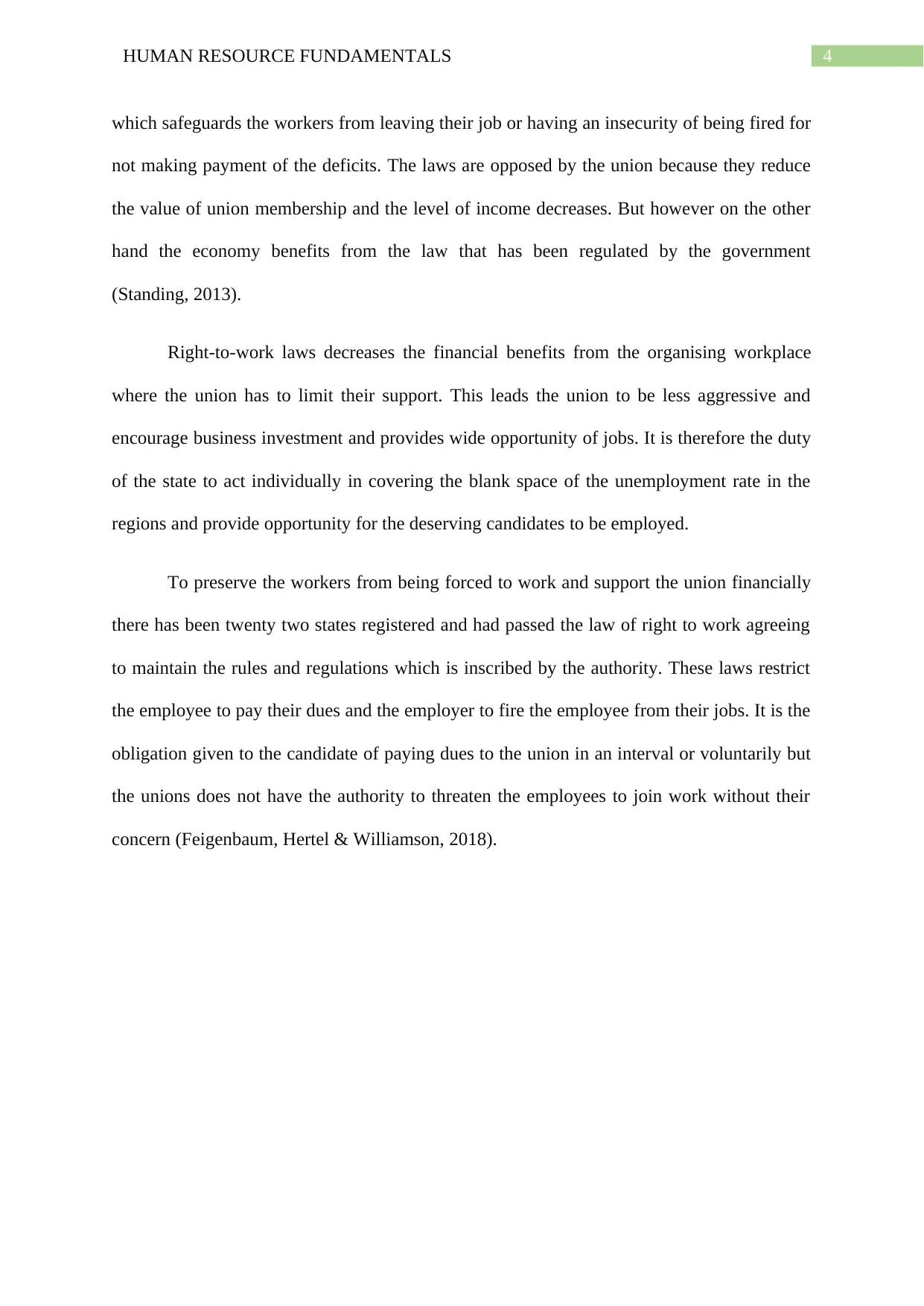
4HUMAN RESOURCE FUNDAMENTALS
which safeguards the workers from leaving their job or having an insecurity of being fired for
not making payment of the deficits. The laws are opposed by the union because they reduce
the value of union membership and the level of income decreases. But however on the other
hand the economy benefits from the law that has been regulated by the government
(Standing, 2013).
Right-to-work laws decreases the financial benefits from the organising workplace
where the union has to limit their support. This leads the union to be less aggressive and
encourage business investment and provides wide opportunity of jobs. It is therefore the duty
of the state to act individually in covering the blank space of the unemployment rate in the
regions and provide opportunity for the deserving candidates to be employed.
To preserve the workers from being forced to work and support the union financially
there has been twenty two states registered and had passed the law of right to work agreeing
to maintain the rules and regulations which is inscribed by the authority. These laws restrict
the employee to pay their dues and the employer to fire the employee from their jobs. It is the
obligation given to the candidate of paying dues to the union in an interval or voluntarily but
the unions does not have the authority to threaten the employees to join work without their
concern (Feigenbaum, Hertel & Williamson, 2018).
which safeguards the workers from leaving their job or having an insecurity of being fired for
not making payment of the deficits. The laws are opposed by the union because they reduce
the value of union membership and the level of income decreases. But however on the other
hand the economy benefits from the law that has been regulated by the government
(Standing, 2013).
Right-to-work laws decreases the financial benefits from the organising workplace
where the union has to limit their support. This leads the union to be less aggressive and
encourage business investment and provides wide opportunity of jobs. It is therefore the duty
of the state to act individually in covering the blank space of the unemployment rate in the
regions and provide opportunity for the deserving candidates to be employed.
To preserve the workers from being forced to work and support the union financially
there has been twenty two states registered and had passed the law of right to work agreeing
to maintain the rules and regulations which is inscribed by the authority. These laws restrict
the employee to pay their dues and the employer to fire the employee from their jobs. It is the
obligation given to the candidate of paying dues to the union in an interval or voluntarily but
the unions does not have the authority to threaten the employees to join work without their
concern (Feigenbaum, Hertel & Williamson, 2018).
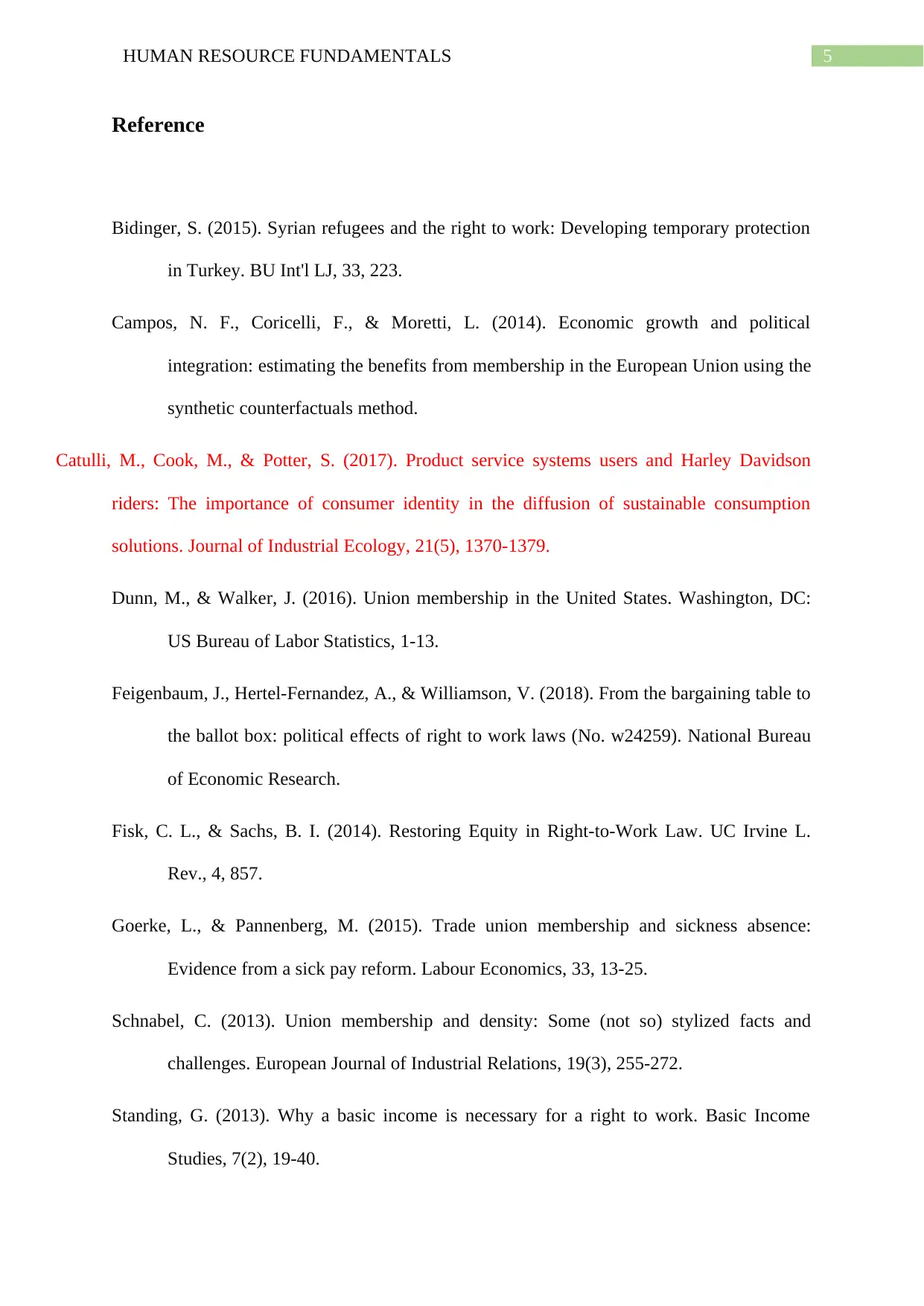
5HUMAN RESOURCE FUNDAMENTALS
Reference
Bidinger, S. (2015). Syrian refugees and the right to work: Developing temporary protection
in Turkey. BU Int'l LJ, 33, 223.
Campos, N. F., Coricelli, F., & Moretti, L. (2014). Economic growth and political
integration: estimating the benefits from membership in the European Union using the
synthetic counterfactuals method.
Catulli, M., Cook, M., & Potter, S. (2017). Product service systems users and Harley Davidson
riders: The importance of consumer identity in the diffusion of sustainable consumption
solutions. Journal of Industrial Ecology, 21(5), 1370-1379.
Dunn, M., & Walker, J. (2016). Union membership in the United States. Washington, DC:
US Bureau of Labor Statistics, 1-13.
Feigenbaum, J., Hertel-Fernandez, A., & Williamson, V. (2018). From the bargaining table to
the ballot box: political effects of right to work laws (No. w24259). National Bureau
of Economic Research.
Fisk, C. L., & Sachs, B. I. (2014). Restoring Equity in Right-to-Work Law. UC Irvine L.
Rev., 4, 857.
Goerke, L., & Pannenberg, M. (2015). Trade union membership and sickness absence:
Evidence from a sick pay reform. Labour Economics, 33, 13-25.
Schnabel, C. (2013). Union membership and density: Some (not so) stylized facts and
challenges. European Journal of Industrial Relations, 19(3), 255-272.
Standing, G. (2013). Why a basic income is necessary for a right to work. Basic Income
Studies, 7(2), 19-40.
Reference
Bidinger, S. (2015). Syrian refugees and the right to work: Developing temporary protection
in Turkey. BU Int'l LJ, 33, 223.
Campos, N. F., Coricelli, F., & Moretti, L. (2014). Economic growth and political
integration: estimating the benefits from membership in the European Union using the
synthetic counterfactuals method.
Catulli, M., Cook, M., & Potter, S. (2017). Product service systems users and Harley Davidson
riders: The importance of consumer identity in the diffusion of sustainable consumption
solutions. Journal of Industrial Ecology, 21(5), 1370-1379.
Dunn, M., & Walker, J. (2016). Union membership in the United States. Washington, DC:
US Bureau of Labor Statistics, 1-13.
Feigenbaum, J., Hertel-Fernandez, A., & Williamson, V. (2018). From the bargaining table to
the ballot box: political effects of right to work laws (No. w24259). National Bureau
of Economic Research.
Fisk, C. L., & Sachs, B. I. (2014). Restoring Equity in Right-to-Work Law. UC Irvine L.
Rev., 4, 857.
Goerke, L., & Pannenberg, M. (2015). Trade union membership and sickness absence:
Evidence from a sick pay reform. Labour Economics, 33, 13-25.
Schnabel, C. (2013). Union membership and density: Some (not so) stylized facts and
challenges. European Journal of Industrial Relations, 19(3), 255-272.
Standing, G. (2013). Why a basic income is necessary for a right to work. Basic Income
Studies, 7(2), 19-40.
⊘ This is a preview!⊘
Do you want full access?
Subscribe today to unlock all pages.

Trusted by 1+ million students worldwide

6HUMAN RESOURCE FUNDAMENTALS
Paraphrase This Document
Need a fresh take? Get an instant paraphrase of this document with our AI Paraphraser

7HUMAN RESOURCE FUNDAMENTALS
Reference apa 8
Reference apa 8
1 out of 8
Your All-in-One AI-Powered Toolkit for Academic Success.
+13062052269
info@desklib.com
Available 24*7 on WhatsApp / Email
![[object Object]](/_next/static/media/star-bottom.7253800d.svg)
Unlock your academic potential
Copyright © 2020–2025 A2Z Services. All Rights Reserved. Developed and managed by ZUCOL.


